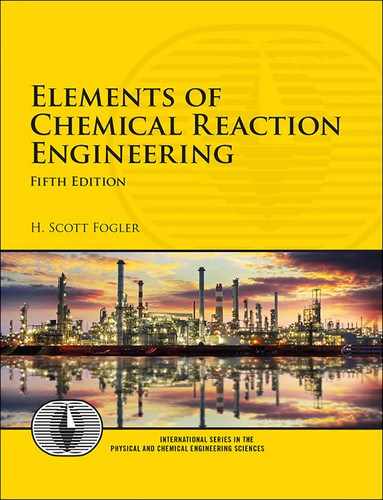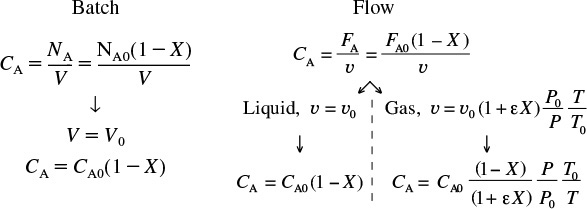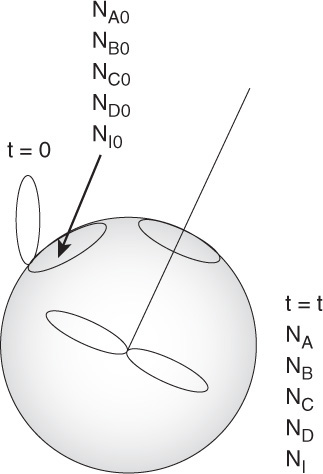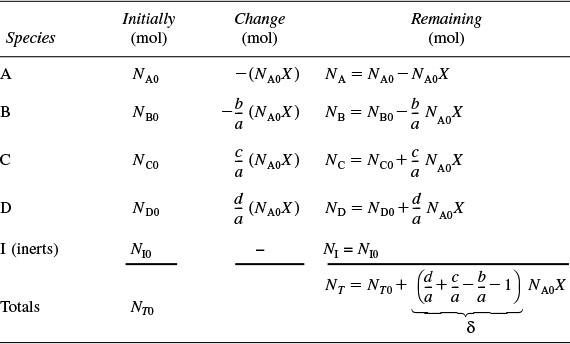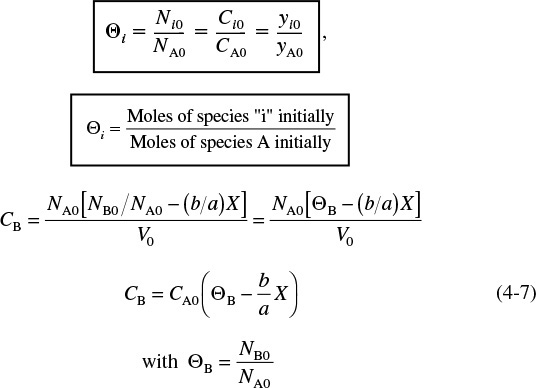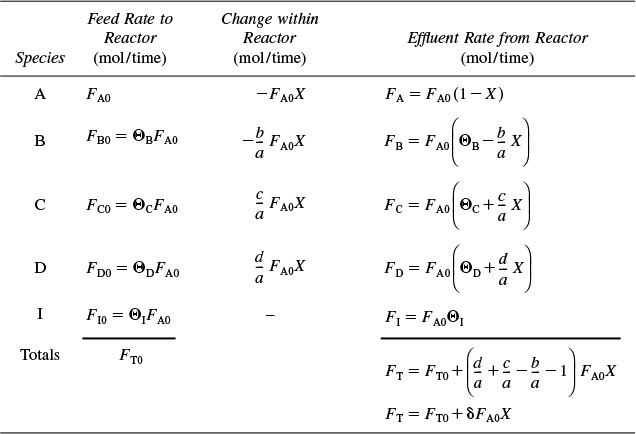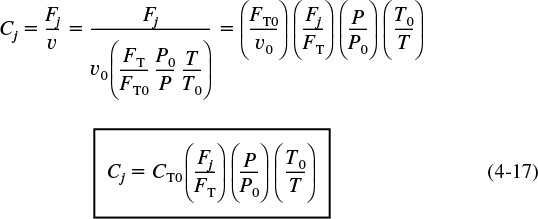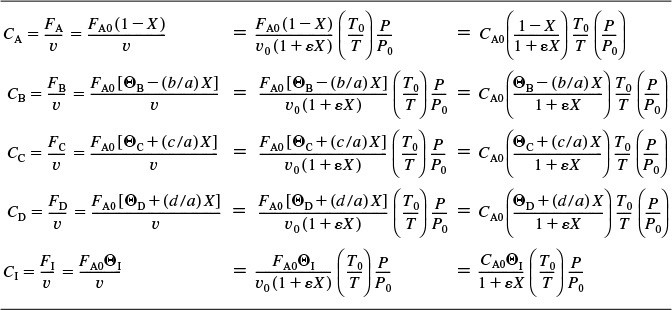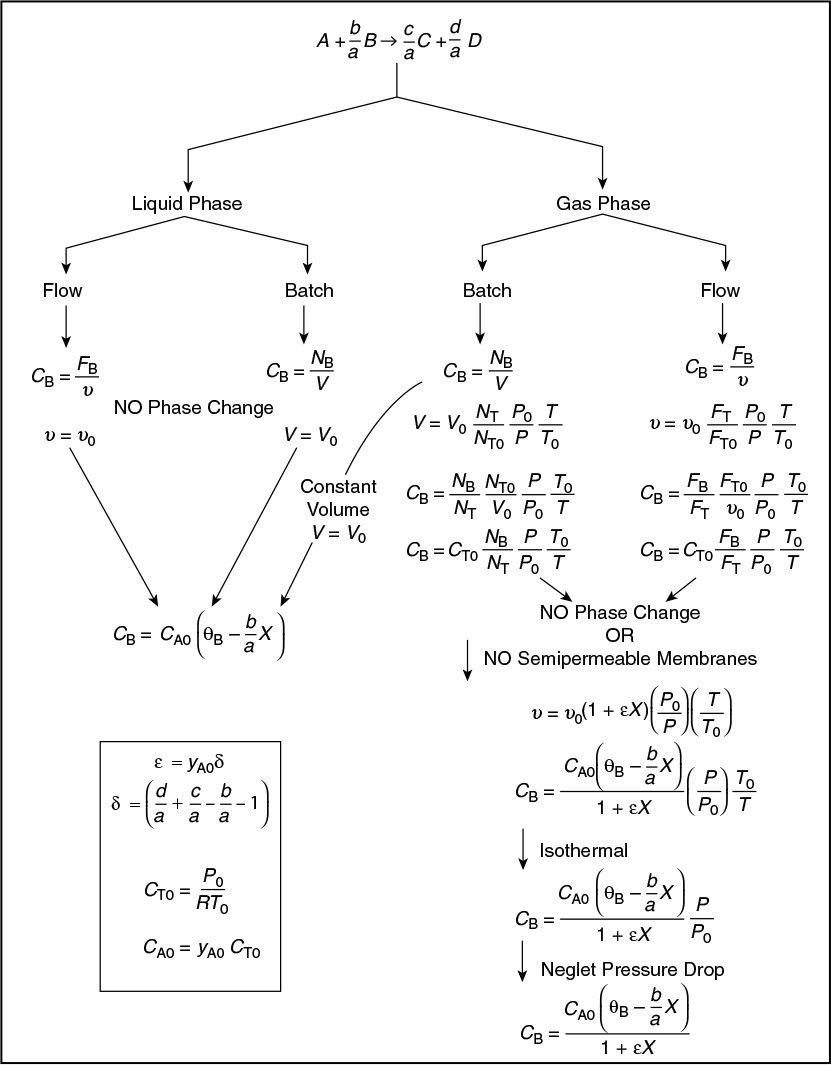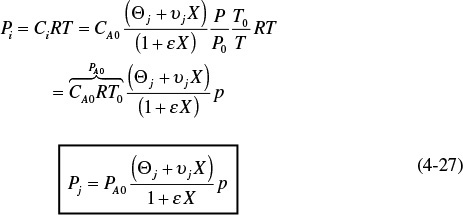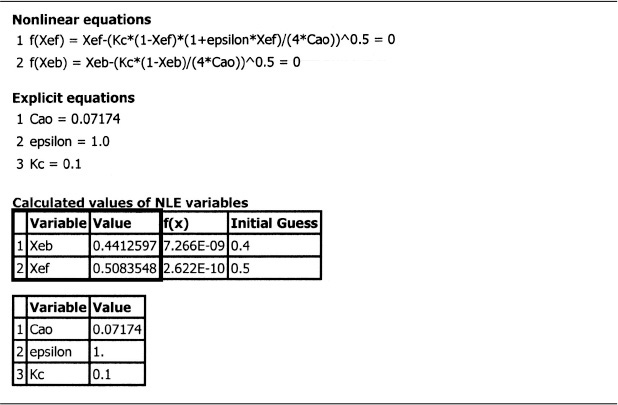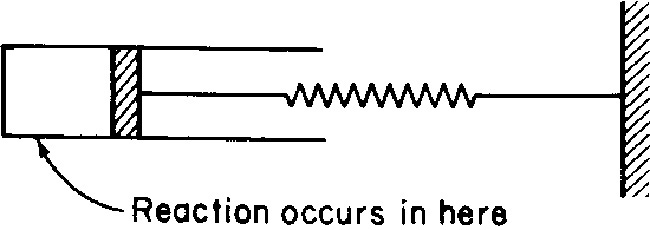4. Stoichiometry
If you are thinking about someone while reading this book, you are most definitely in LOVE.
—Tim Newberger Undergraduate ChE Student W2013
Now that we have shown how the rate law can be expressed as a function of concentrations, we need only express concentration as a function of conversion in order to carry out calculations similar to those presented in Chapter 2 to size reactors. If the rate law depends on more than one species, we must relate the concentrations of the different species to each other. This relationship is most easily established with the aid of a stoichiometric table. This table presents the stoichiometric relationships between reacting molecules for a single reaction. That is, it tells us how many molecules of one species will be formed during a chemical reaction when a given number of molecules of another species disappears. These relationships will be developed for the general reaction
Recall that we have already used stoichiometry to relate the relative rates of reaction for Equation (2-1):
This stoichiometric relationship relating reaction rates will be used in Chapters 6 and 8.
In formulating our stoichiometric table, we shall take species A as our basis of calculation (i.e., the limiting reactant) and then divide through by the stoichiometric coefficient of A
in order to put everything on a basis of “per mole of A.”
Next, we develop the stoichiometric relationships for reacting species that give the change in the number of moles of each species (i.e., A, B, C, and D).
4.1 Batch Systems
Batch reactors are primarily used for the production of specialty chemicals and to obtain reaction rate data in order to determine reaction rate laws and rate-law parameters such as k, the specific reaction rate.
Figure 4-1 shows a starving artist’s rendition of a batch system in which we will carry out the reaction given by Equation (2-2). At time t = 0, we will open the reactor and place a number of moles of species A, B, C, and D, and inerts I(NA0, NB0, NC0, ND0, and NI0, respectively) into the reactor.
Species A is our basis of calculation, and NA0 is the number of moles of A initially present in the reactor. After a time t, NA0X moles of A are consumed in the system as a result of the chemical reaction, leaving (NA0 – NA0X) moles of A in the system. That is, the number of moles of A remaining in the reactor after a conversion X has been achieved is
NA = NA0 – NA0X = NA0(1 – X)
We now will use conversion in a similar fashion to express the number of moles of B, C, and D in terms of conversion.
To determine the number of moles of each species remaining after NA0X moles of A have reacted, we form the stoichiometric table (Table 4-1). This stoichiometric table presents the following information:
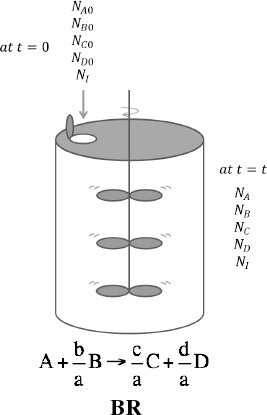
Column 1: the species in the reaction
Column 2: the number of moles of each species initially present
Column 3: the change in the number of moles brought about by reaction
Column 4: the number of moles remaining in the system at time t
Components of the stoichiometric table
To calculate the number of moles of species B remaining at time t, we recall that at time t the number of moles of A that have reacted is NA0X. For every mole of A that reacts, b/a moles of B must react; therefore, the total number of moles of B that have reacted is

Because B is disappearing from the system, the sign of the “change” is negative. NB0 is the number of moles of B initially in the system. Therefore, the number of moles of B remaining in the system, NB, at a time t, is given in the last column of Table 4-1 as
The complete stoichiometric table delineated in Table 4-1 is for all species in the general reaction
Let’s take a look at the totals in the last column of Table 4-1. The stoichiometric coefficients in parentheses (d/a + c/a – b/a – 1) represent the change in the total number of moles per mole of A reacted. Because this term occurs so often in our calculations, it is given the symbol δ:
The parameter δ

Definition of δ
The total number of moles can now be calculated from the equation
NT = NT0 + δ(NA0X)
We recall from Chapter 1 and Chapter 3 that the kinetic rate law (e.g., ![]() ) is a function solely of the intensive properties of the reacting system (e.g., temperature, pressure, concentration, and catalysts, if any). The reaction rate, –rA, usually depends on the concentration of the reacting species raised to some power. Consequently, to determine the reaction rate as a function of conversion, X, we need to know the concentrations of the reacting species as a function of conversion, X.
) is a function solely of the intensive properties of the reacting system (e.g., temperature, pressure, concentration, and catalysts, if any). The reaction rate, –rA, usually depends on the concentration of the reacting species raised to some power. Consequently, to determine the reaction rate as a function of conversion, X, we need to know the concentrations of the reacting species as a function of conversion, X.
We want Cj = hj(X)
4.1.1 Batch Concentrations for the Generic Reaction, Equation (2-2)
The concentration of A is the number of moles of A per unit volume
Batch concentration
After writing similar equations for B, C, and D, we use the stoichiometric table to express the concentration of each component in terms of the conversion X:
Because almost all batch reactors are solid vessels, the reactor volume is constant, so we can take V = V0, then
We will soon see that Equation (4-6) also applies to liquid systems.
We further simplify these equations by defining the parameter Θj, which allows us to factor out NA0 in each of the expressions for concentration
Feed
Equalmolar: ΘB = 1
Stoichiometric: ![]()
for an equalmolar feed ΘB = 1 and for a stoichiometric feed ΘB = b/a.
Continuing for species C and D
Constant-volume batch concentrations
For constant-volume batch reactors, e.g., steel containers V = V0, we now have concentration as a function of conversion. If we know the rate law, we can now obtain –rA = f(X) to couple with the differential mole balance in terms of conversion in order to solve for the reaction time, t.
For liquid-phase reactions taking place in solution, the solvent usually dominates the situation. For example, most liquid-phase organic reactions do not change density during the course of the reaction and represent still another case for which the constant-volume simplifications apply. As a result, changes in the density of the solute do not affect the overall density of the solution significantly and therefore it is essentially a constant-volume reaction process, V = V0 and υ = υ0. Consequently, Equations (4-6) through (4-9) can be used for liquid-phase reactions as well. An important exception to this general rule exists for polymerization processes.
For liquids V = V0 and υ = υ0
To summarize for constant-volume batch systems and for liquid-phase reactions, we can use a rate law for reaction (2-2) such as –rA = kACACB to obtain –rA = f(X) ; that is,
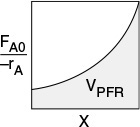
Substituting for the given parameters k, CA0, and ΘB, we can now use the techniques in Chapter 2 to size the CSTRs and PFRs for liquid-phase reactions.
Example 4–1 Expressing Cj = hj(X) for a Liquid-Phase Batch Reaction
Soap consists of the sodium and potassium salts of various fatty acids, such as oleic, stearic, palmitic, lauric, and myristic acids. The saponification for the formation of soap from aqueous caustic soda and glyceryl stearate is
Letting X represent the conversion of sodium hydroxide (the moles of sodium hydroxide reacted per mole of sodium hydroxide initially present), set up a stoichiometric table expressing the concentration of each species in terms of its initial concentration and the conversion, X.
Solution
Because we have taken sodium hydroxide as our basis of calculation, we divide through by the stoichiometric coefficient of sodium hydroxide to put the reaction expression in the form

Choosing a basis of calculation
We may then perform the calculations shown in Table E4-1.1. Because this is a liquid-phase reaction, the density ρ is considered to be constant; therefore, V = V0.

Analysis: The purpose of this example was to show how the generic reaction in Table 4-1 is applied to a real reaction.
Stoichiometric table (batch)
Example 4–2 What Is the Limiting Reactant?
Having set up the stoichiometric table in Example 4-1, one can now readily use it to calculate the concentrations at a given conversion. If the initial mixture consists of sodium hydroxide at a concentration of 10 mol/dm3 (i.e., 10 mol/L or 10 kmol/m3) and glyceryl stearate at a concentration of 2 mol/dm3, what are the concentrations of glycerol stearate, B, and of glycerine, D, when the conversion of sodium hydroxide is (a) 20% and (b) 90%?
Solution
Only the reactants NaOH and (C17H35 COO)3C3H5 are initially present; therefore, ΘC = ΘD = 0.
(a) For 20% conversion of NaOH

(b) For 90% conversion of NaOH

Let us find CB

Oops!! Negative concentration—impossible! What went wrong?
Analysis: We chose the wrong basis of calculation! We must choose the limiting reactant as our basis of calculation. Ninety-percent conversion of NaOH is not possible because glyceryl stearate is the limiting reactant and is used up before 90% of the NaOH can be reacted. Glyceryl stearate should have been our basis of calculation and therefore we should not have divided the reaction as written by the stoichiometric coefficient of 3.
The basis of calculation must be the limiting reactant.
4.2 Flow Systems
The form of the stoichiometric table for a continuous-flow system (see Figure 4-2) is virtually identical to that for a batch system (Table 4-1), except that we replace Nj0 by Fj0 and Nj by Fj (Table 4-2). Again taking A as the basis, we divide Equation (2-1) through by the stoichiometric coefficient of A to obtain
Stoichiometric table for a flow system

and ΘC, ΘD, and ΘI are defined similarly
4.2.1 Equations for Concentrations in Flow Systems
For a flow system, the concentration CA at a given point can be determined from the molar flow rate FA and the volumetric flow rate υ at that point:
Definition of concentration for a flow system
Units of υ are typically given in terms of liters per second, cubic decimeters per second, or cubic feet per minute. We now can write the concentrations of A, B, C, and D for the general reaction given by Equation (2-2) in terms of their respective entering molar flow rates (FA0, FB0, FC0, FD0), the conversion, X, and the volumetric flow rate, υ.
4.2.2 Liquid-Phase Concentrations
For liquids, the fluid volume change with reaction is negligible when no phase changes are taking place. Consequently, we can take
υ = υ0
For liquids
CA = CA0(1–X)
![]()
Therefore, for a given rate law we have –rA = g(X)
Then
and so forth for CC and CD.
Consequently, using any one of the rate laws in Chapter 3, we can now find –rA = f(X) for liquid-phase reactions. However, for gas-phase reactions the volumetric flow rate most often changes during the course of the reaction because of a change in the total number of moles or a change in temperature or pressure. Hence, one cannot always use Equation (4-13) to express concentration as a function of conversion for gas-phase reactions.
4.2.3 Gas-Phase Concentrations
In our previous discussions, we considered primarily systems in which the reaction volume or volumetric flow rate did not vary as the reaction progressed. Most batch and liquid-phase and some gas-phase systems fall into this category. There are other systems, though, in which either V or υ does vary, and these will now be considered.
A situation where one encounters a varying flow rate occurs quite frequently in gas-phase reactions that do not have an equal number of product and reactant moles. For example, in the synthesis of ammonia

4 mol of reactants gives 2 mol of product. In flow systems where this type of reaction occurs, the molar flow rate will be changing as the reaction progresses. Because equal numbers of moles occupy equal volumes in the gas phase at the same temperature and pressure, the volumetric flow rate will also change.
In the stoichiometric tables presented on the preceding pages, it was not necessary to make assumptions concerning a volume change in the first four columns of the table (i.e., the species, initial number of moles or molar feed rate, change within the reactor, and the remaining number of moles or the molar effluent rate). All of these columns of the stoichiometric table are independent of the volume or density, and they are identical for constant-volume (constant-density) and varying-volume (varying-density) situations. Only when concentration is expressed as a function of conversion does variable density enter the picture.
Flow Reactors with Variable Volumetric Flow Rate
To derive the concentrations of each species in terms of conversion for a gas-phase flow system, we shall use the relationships for the total concentration. The total concentration, CT, at any point in the reactor is the total molar flow rate, FT, divided by the volumetric flow rate, υ [cf. Equation (4-10)]. In the gas phase, the total concentration is also found from the gas law, CT = P/ZRT. Equating these two relationships gives
At the entrance to the reactor
Taking the ratio of Equation (4-14) to Equation (4-15) and assuming negligible changes in the compressibility factor, i.e., Z≅Z0, during the course of the reaction we have upon rearrangement
Gas-phase reactions
We can now express the concentration of species j for a flow system in terms of its flow rate, Fj, the temperature, T, and total pressure, P.
Use this concentration equation for membrane reactors (Chapter 6) and for multiple reactions (Chapter 8).
The total molar flow rate is just the sum of the molar flow rates of each of the species in the system and is
We can also write equation (4-17) in terms of the mole fraction of species j, yj, and the pressure ratio, p, with respect to the initial or entering conditions, i.e., sub “0”
The molar flow rates, Fj, are found by solving the mole balance equations. The concentration given by Equation (4-17) will be used for measures other than conversion when we discuss membrane reactors (Chapter 6) and multiple gas-phase reactions (Chapter 8).
Now, let’s express the concentration in terms of conversion for gas flow systems. From Table 4-2, the total molar flow rate can be written in terms of conversion and is
FT = FT0 + FA0δX
We divide this equation through by FT0

Then
where yA0 is the mole fraction of A at the inlet (i.e., (FA0/FT0)), and where δ is given by Equation (4-1) and ε is given by
Relationship between δ and ε
Equation (4-21) holds for both batch and flow systems. To interpret ε, let’s rearrange Equation (4-20) at complete conversion (i.e., X = 1 and FT = FTf)
Interpretation of ε
Substituting for (FT/FT0) in Equation (4-16) for the volumetric flow rate, υ, we have
Gas-phase volumetric flow rate
The concentration of species j in a flow system is
The molar flow rate of species j is
Fj = Fj0 + υj(FA0X) = FA0(Θj + υjX)
where υi is the stoichiometric coefficient, which is negative for reactants and positive for products. For example, for the reaction
Substituting for υ using Equation (4-23) and for Fj, we have

Rearranging
Gas-phase concentration as a function of conversion
Recall that yA0 = FA0/FT0, CA0 = yA0CT0, and ε is given by Equation (4-21) (i.e., ε = yA0δ).
The stoichiometric table for the gas-phase reaction (2-2) is given in Table 4-3.
At last! We now have Cj = hj(X) and –rA = g(X) for variable-volume gas-phase reactions.
One of the major objectives of this chapter is to learn how to express any given rate law –rA as a function of conversion. The schematic diagram in Figure 4-3 helps to summarize our discussion on this point. The concentration of the reactant species B in the generic reaction is expressed as a function of conversion in both flow and batch systems for various conditions of temperature, pressure, and volume.
Example 4–3 Determining Cj = hj(X) for a Gas-Phase Reaction
A mixture of 28% SO2 and 72% air is charged to a flow reactor in which SO2 is oxidized.
(a) First, set up a stoichiometric table using only the symbols (i.e., Θi, Fi).
(b) Next, prepare a second table evaluating the species concentrations as a function of conversion for the case when the total pressure is 1485 kPa (14.7 atm) and the temperature is constant at 227°C.
(c) Evaluate the parameters and make a plot of each of the concentrations SO2, SO3, N2 as a function of conversion
Solution
(a) Stoichiometric table. Taking SO2 as the basis of calculation, we divide the reaction through by the stoichiometric coefficient of our chosen basis of calculation
The stoichiometric table is given in Table E4-3.1.
(b) Expressing the concentration as a function of conversion.
From the definition of conversion, we substitute not only for the molar flow rate of SO2(A) in terms of conversion but also for the volumetric flow rate as a function of conversion
Recalling Equation (4-23), we have
Neglecting pressure drop in the reaction, P = P0, yields
Neglecting pressure drop, P = P0
If the reaction is also carried out isothermally, T = T0, we obtain
υ = υ0(1 + εX)

Isothermal operation, T = T0
Similarly for B also with T = T0 and P = P0, (i.e., p = 1)

(c) Parameter evaluation and concentrations of a function of conversion plot. The inlet concentration of A is equal to the inlet mole fraction of A multiplied by the total inlet molar concentration. The total concentration can be calculated from an equation of state such as the ideal gas law. Recall that yA0 = 0.28, T0 = 500 K, and P0 = 1485 kPa.

The total concentration at constant temperature and pressure is
We now evaluate ε.
Initially, 72% of the total number of moles is air containing 21% O2 and 79% N2, along with 28% SO2.
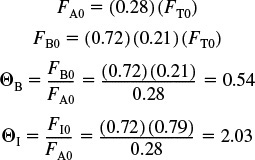
Substituting for CA0 and ε in the species concentrations:
The concentrations of different species at various conversions are calculated in Table E4-3.2 and plotted in Figure E4-3.1. Note that the concentration of N2 is changing even though it is an inert species in this reaction!!
Note: Because the volumetic flow rate varies with conversion, υ = υ0(1–0.14X), the concentration of inerts (N2) is not constant.
Now use techniques presented in Chapter 2 to size reactors.
We are now in a position to express –rA as a function of X and use the techniques in Chapter 2. However, we will use a better method to solve CRE problems, namely a Table of Integrals (Appendix A) or the Polymath software, discussed in the next chapter.
Analysis: In this example, we formed a stoichiometric table in terms of molar flow rates. We then showed how to express the concentrations of each species in a gas-phase reaction in which there is a change in the total number of moles. Next, we plotted each species concentration as a function of conversion and noted that the concentration of the inert, N2, was not constant but increased with increasing conversion because of the decrease in the total molar flow rate, FT, with conversion.
As previously mentioned many, if not most, rate laws for catalyst reactions are given in terms of partial pressures. Luckily, partial pressures are easily related to conversion with the aid of the ideal gas law and Equation (4-17).

The following equation is used when the mole balance is written in terms of molar flow rates
However, when the mole balance is written in terms of conversion, we use Equation (4-25)
For example, the rate law for the hydrodemethylation of toluene (T) to form methane (M) and benzene (B) given by Equation (10-80) on page 440 can now be written in terms of conversion.

T + H2 → M + B
If you haven’t decided which computer to buy or borrow, or don’t have your integral tables, you could resort to the graphical techniques in Chapter 2 and use a Levenspiel plot, (![]() ) versus X, to achieve a specified conversion of toluene.
) versus X, to achieve a specified conversion of toluene.
Example 4–4 Expressing the Rate Law for SO2 Oxidation in Terms of Partial Pressures and Conversions
The SO2 oxidation discussed in Example 4-3 is to be carried out over a solid platinum catalyst. As with almost all gas-solid catalytic reactions, the rate law is expressed in terms of partial pressures instead of concentrations. The rate law for this SO2 oxidation was found experimentally to be1
1 Uychara, O.A. and K. M. Watson, Ind. Engrg. Chem. 35 p.541.
where Pi (atm) is the partial pressure of species i.
The reaction is to be carried out isothermally at 400°C. At this temperature the rate constant k per gram of catalyst (g-cat), the adsorption constants for O2(Ko2) and SO2 (Kso2), and the pressure equilibrium constant, Kp, were experimentally found to be:
k = 9.7 mol SO2/atm3/2/h/g-cat
Ko2 = 38.5 atm–1, Kso2 = 42.5 atm–1, and KP = 930atm–1/2
The total pressure and the feed composition (e.g., 28% SO2) are the same as in Example 4-3. Consequently, the entering partial pressure of SO2 is 4.1 atm. There is no pressure drop.
Write the rate law as a function of conversion.
Solution
No Pressure Drop and Isothermal Operation
For SO2
First we need to recall the relationship between partial pressure and concentration, followed by the relationship between concentration and conversion. Because we know how to express concentration as a function of conversion, we know how to express partial pressure as a function of conversion.
For no pressure drop P = P0, i.e., p = 1
For SO3
For O2
From Example 4-3
ΘB = 0.54
Factoring out ![]() in Equation (E4-4.5) gives
in Equation (E4-4.5) gives
From Equation (E4-3.5)
Substitute for the partial pressure in the rate-law equation (E4-4.1)
with k = 9.7 mol SO2/atm3/2/h/g-cat PSO2,0 = 4.1 atm, ![]()
We could now use a Levenspiel plot to find the catalyst weight W in a packed-bed reactor (PBR) to achieve a specified conversion.
However, we will see in the next chapter there is a much, much better way to solve for the catalysis weight, W, by using numerical software packages. For example, we would couple Equation (E4-4.8) with Equation (2-17) and use an ordinary differential equation (ODE) solver, such as Polymath, to find the conversion X as a function of catalyst weight W. So, be sure to buy or borrow a laptop computer before attempting to solve the problems in Chapter 5 and beyond.
Analysis: In most heterogeneous catalytic reactions, rate laws are expressed in terms of partial pressures instead of concentration. However, we see that through the use of the ideal gas law we could easily express the partial pressure as a function of concentration then conversion in order to express the rate law as a function of conversion. In addition, for most all heterogeneous reactions you will usually find a term like (1 + KAPA + KBPB + ...) in the denominator of the rate law, as will be explained in Chapter 10.
4.3 Reversible Reactions and Equilibrium Conversion
Thus far in this chapter, we have focused mostly on irreversible reactions. The procedure one uses for the isothermal reactor design of reversible reactions is virtually the same as that for irreversible reactions, with one notable exception: the maximum conversion that can be achieved at the reaction temperature is the equilibrium conversion, Xe. In the following example, it will be shown how our algorithm for reactor design is easily extended to reversible reactions.
Need to first calculate Xe
Example 4–5 Calculating the Equilibrium Conversion
The reversible gas-phase decomposition of nitrogen tetroxide, N2O4, to nitrogen dioxide, NO2,
is to be carried out at constant temperature. The feed consists of pure N2O4 at 340 K and 202.6 kPa (2 atm). The concentration equilibrium constant, KC, at 340 K is 0.1 mol/dm3 and the rate constant kN2O4 is 0.5min–1.
(a) Set up a stoichiometric table and then calculate the equilibrium conversion of N2O4 in a constant-volume batch reactor.
(b) Calculate the equilibrium conversion of N2O4 in a flow reactor.
(c) Assuming the reaction is elementary, express the rate of reaction solely as a function of conversion for a flow system and for a batch system.
(d) Determine the CSTR volume necessary to achieve 80% of the equilibrium conversion.
Solution

At equilibrium, the concentrations of the reacting species are related by the relationship dictated by thermodynamics (see Equation (3-10) and Appendix C).
(a) Batch system—constant volume, V = V0.

At equilibrium, X = Xe, we substitute Equations (E4-5.2) and (E4-5.3) into Equation (E4-5.1)
(math-math-math-math) to get
We will use the software package Polymath to solve for the equilibrium conversion and let Xeb represent the equilibrium conversion in a constant-volume batch reactor. Equation (E4-5.4) written in Polymath format becomes
f(Xeb) = Xeb – [kc*(1– Xeb)/(4*cao)]^0.5
The Polymath program and solution are given in Table E4-5.2.
When looking at Equation (E4-5.4), you probably asked yourself, “Why not use the quadratic formula to solve for the equilibrium conversion in both batch and flow systems?” That is

There is a Polymath tutorial in the Summary Notes for Chapter 1 on the CRE Web site.
The answer is that future problems will be nonlinear and require Polymath solutions; therefore, this simple exercise increases the reader’s ease in using Polymath.
The equilibrium conversion in a constant-volume batch reactor is
Note: A tutorial on Polymath can be found in the summary notes for Chapter 1 on the CRE Web site (www.umich.edu/~elements/5e/index.html).
Polymath Tutorial Chapter 1

(b) Flow system. The stoichiometric table is the same as that for a batch system except that the number of moles of each species, Ni, is replaced by the molar flow rate of that species, Fi. For constant temperature and pressure, the volumetric flow rate is υ = υ0(1 + εX), and the resulting concentrations of species A and B are
At equilibrium, X = Xe, we can substitute Equations (E4-5.5) and (E4-5.6) into Equation (E4-5.1) to obtain the expression
Simplifying gives
Rearranging to use Polymath yields
For a flow system with pure N2O4 feed, ε = yA0 δ = 1(2–1) = 1.
We shall let Xef represent the equilibrium conversion in a flow system. Equation (E4-5.8) written in the Polymath format becomes
f(Xef) = Xef–[kc*(1–Xef)*(1 + eps*Xef)/4/cao]^0.5
This solution is also shown in Table E4-5.2 ![]() .
.
Note that the equilibrium conversion in a flow reactor (i.e., Xef = 0.51), with no pressure drop, is greater than the equilibrium conversion in a constant-volume batch reactor (Xeb = 0.44). Recalling Le Châtelier’s principle, can you suggest an explanation for this difference in Xe?
(c) Rate laws. Assuming that the reaction follows an elementary rate law, then
1. For a constant volume (V = V0) batch system
Here, CA = NA/V0 and CB = NB/V0. Substituting Equations (E4-5.2) and (E4-5.3) into the rate law, we obtain the rate of disappearance of A as a function of conversion
–rA = f(X) for a batch reactor with V = V0
2. For a flow system
Here, CA = FA/υ and CB = FB/υ with υ = υ0(1 + εX). Consequently, we can substitute Equations (E4-5.5) and (E4-5.6) into Equation (E4-5.9) to obtain
–rA = f(X) for a flow reactor
As expected, the dependence of reaction rate on conversion for a constantvolume batch system [i.e., Equation (E4-5.10)] is different than that for a flow system [Equation (E4-5.11)] for gas-phase reactions.
If we substitute the values for CA0, KC, ε, and kA = 0.5 min–1 in Equation (E4-5.11), we obtain –rA solely as a function of X for the flow system.
We can now prepare our Levenspiel plot.
We see as we approach equilibrium, –rA goes to zero and (1/–rA) goes to infinity as X approaches Xe.
(d) CSTR volume. Just for fun (and this really is fun), let’s calculate the CSTR reactor volume necessary to achieve 80% of the equilibrium conversion of 51% (i.e., X = 0.8Xe = (0.8)(0.51) = 0.4) for a molar feed rate of A of 3 mol/min.
Evaluating Equation E4-5.12 at X = 0.4
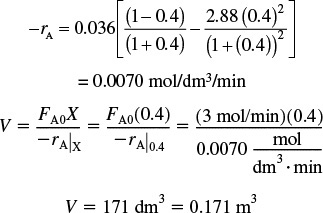
The CSTR volume necessary to achieve 40% conversion is 0.171 m3.
Analysis: The purpose of this example was to calculate the equilibrium conversion first for a constant volume batch reactor in part (a), and then for a constant pressure flow reactor in part (b). One notes that there is a change in the total number of moles in this reaction and, as a result, these two equilibrium conversions are not the same!! We next showed in part (c) how to express –rA = f(X) for a reversible gas-phase reaction. Finally, in Part (d) having –rA = f(X), we specified a molar flow rate of A (i.e., 3.0 mol A/min) and calculated the CSTR volume necessary to achieve 40% conversion. We did this calculation to give insight to the types of analyses we, as chemical reaction engineers, will carry out as we move into similar but more complex calculations in Chapters 5 and 6.
Summary
1. The stoichiometric table for the reaction given by Equation (S4-1) being carried out in a flow system is
2. In the case of ideal gases, Equation (S4-3) relates volumetric flow rate to conversion.
For the general reaction given by (S4-1), we have
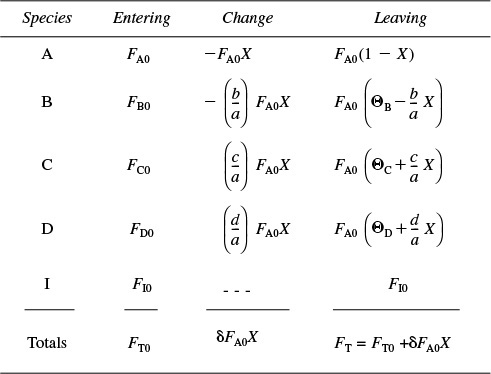
and
3. For incompressible liquids or for batch gas phase reactions taking place in a constant volume, V = V0, the concentrations of species A and C in the reaction given by Equation (S4-1) can be written as
Equations (S4-7) and (S4-8) also hold for gas-phase reactions carried out in constant-volume batch reactors.
4. For gas-phase reactions, we use the definition of concentration (CA = FA/υ) along with the stoichiometric table and Equation (S4-3) to write the concentration of A and C in terms of conversion.
with ![]()
5. In terms of gas-phase molar flow rates, the concentration of species i is
Equation (S4-11) must be used for membrane reactors (Chapter 6) and for multiple reactions (Chapter 8).
6. Many catalytic rate laws are given in terms of partial pressure, e.g.,
The partial pressure is related to conversion through the stoichiometric table. For any species “i” in the reaction
For species A
CRE Web Site Materials
• Expanded Material
1. Web P4–1B Puzzle Problem “What Four Things Are Wrong with This Solution?”
• Learning Resources
1. Summary Notes for Chapter 4
2. Interactive Computer Games
Quiz Show II
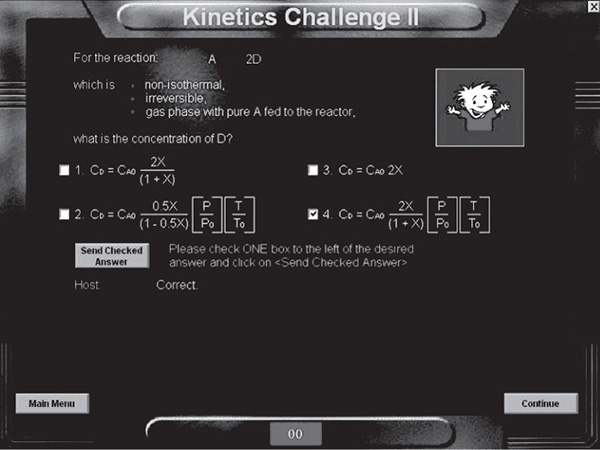
3. Solved Problems
CDP4-BB Microelectronics Industry and the Stoichiometric Table
• Living Example Problems
1. Example 4-5 Calculating the Equilibrium Conversion
• FAQ (Frequently Asked Questions)—In Updates/FAW icon section
• Professional Reference Shelf
Questions and Problems
The subscript to each of the problem numbers indicates the level of difficulty: A, least difficult; D, most difficult.
Questions
Q4-1A
(a) List the important concepts that you learned from this chapter. Make a list of concepts that you are not clear about and ask your instructor or colleague about them.
(b) Explain the strategy to evaluate reactor design equations and how this chapter expands on Chapters 2 and 3.
(a) Example 4-1. Would the example be correct if water were considered an inert? Explain.
(b) Example 4-2. How would the answer change if the initial concentration of glyceryl stearate were 3 mol/dm3? Rework Example 4-2 correctly using the information given in the problem statement.
(c) Example 4-3. Under what conditions will the concentration of the inert nitrogen be constant? Plot Equation (E4-5.2) in terms of (1/–rA) as a function of X up to value of X = 0.99. What did you find?
(e) Example 4-4. Why is the equilibrium conversion lower for the batch system than the flow system? Will this always be the case for constant-volume batch systems? For the case in which the total concentration CT0 is to remain constant as the inerts are varied, plot the equilibrium conversion as a function of the mole fraction of inerts for both a PFR and a constant-volume batch reactor. The pressure and temperature are constant at 2 atm and 340 K. Only N2O4 and inert I are to be fed. Go to the Living Example Problems and load Wolfram. (1) What values of KC, CA0, and ε cause Xef to be the farthest away from Xeb?(2) At what value CA0 will Xeb and Xef be closest together?
(d) Example 4-5. (a) Using the molar flow rate of A of 3 mol/minute and Figure E4-5.1, calculate the PBR volume necessary for 40% conversion. (b) Next consider the entering flow rate of SO2 is 1,000 mol/h. Plot (![]() ) as a function of X to determine the PBR catalyst weight to achieve (1) 30% conversion, (2) 40% conversion, and (3)99% of the equilibrium conversion, i.e., X = 0.99Xe.
) as a function of X to determine the PBR catalyst weight to achieve (1) 30% conversion, (2) 40% conversion, and (3)99% of the equilibrium conversion, i.e., X = 0.99Xe.
P4-2A Load the Interactive Computer Games (ICG) Kinetic Challenge from the CRE Web site. Play the game and then record your performance number for the module that indicates your mastering of the material. Your professor has the key to decode your performance number. ICG Kinetics Challenge Performance # ____________.

P4-3A The elementary reversible reaction
is carried out in a flow reactor where pure A is fed at a concentration of 4.0 mol/dm3. If the equilibrium conversion is found to be 60%,
(a) What is the equilibrium constant, KC if the reaction is a gas phase reaction? (Ans.: Gas: KC = 0.328 dm3/mol)
(b) What is the KC if the reaction is a liquid-phase reaction? ( Ans.: Liquid: KC = 0.469 dm3/mol)
(c) Write –rA solely as a function of conversion (i.e., evaluating all symbols) when the reaction is an elementary, reversible, gas-phase, isothermal reaction with no pressure drop with kA = 2 dm6/mol⋅s and KC = 0.5 all in proper units.
(d) Repeat (c) for a constant-volume batch reactor.
P4-4B Stoichiometry. The elementary gas reaction
2A + B → C
is carried out isothermally in a PFR with no pressure drop. The feed is equal molar in A and B, and the entering concentration of A is 0.1 mol/dm3. Set up a stoichiometric table and then determine the following.
(a) What is the entering concentration (mol/dm3) of B?
(b) What are the concentrations of A and C (mol/dm3) at 25% conversion of A?
(c) What is the concentration of B(mol/dm3) at 25% conversion of A? (Ans.: CB = 0.1 mol dm3)
(d) What is the concentration of B(mol/dm3) at 100% conversion of A?
(e) If at a particular conversion the rate of formation of C is 2 mol/min/dm3, what is the rate of formation of A at the same conversion?
(f) Write –rA solely as a function of conversion (i.e., evaluating all symbols) when the reaction is an elementary, irreversible, gas-phase, isothermal reaction with no pressure drop with an equal molar feed and with CA0 = 2.0 mol/dm3 at, kA = 2dm6/mol·s.
(g) What is the rate of reaction at X = 0.5?
P4-5A Set up a stoichiometric table for each of the following reactions and express the concentration of each species in the reaction as a function of conversion, evaluating all constants (e.g., ε, Θ). Next, assume the reaction follows an elementary rate law, and write the reaction rate solely as a function of conversion, i.e., –rA = f(X).
(a) For the liquid-phase reaction

the entering concentrations of ethylene oxide and water, after mixing the inlet streams, are 16.13 mol/dm3 and 55.5 mol/dm3, respectively. The specific reaction rate is k = 0.1dm3/mol·s at 300 K with E = 12,500cal/mol.
(1) After finding –rA = f(X), calculate the CSTR space-time, τ, for 90% conversion at 300 K and also at 350 K.
(2) If the volumetric flow rate is 200 liters per second, what are the corresponding reactor volume? (Ans.: At 300 K: V = 439 dm3 and at 350 K: V = 22 dm3)
(b) For the isothermal, isobaric gas-phase pyrolysis
pure ethane enters a flow reactor at 6 atm and 1100 K. Set up a stoichiometric table and then write –rA = f(X). How would your equation for the concentration and reaction rate, i.e., –rA = f(X), change if the reaction were to be carried out in a constant-volume batch reactor?
(c) For the isothermal, isobaric, catalytic gas-phase oxidation

the feed enters a PBR at 6 atm and 260°C, and is a stoichiometric mixture of only oxygen and ethylene. Set up a stoichiometric table and then write ![]() as a function of partial pressures. Express the partial pressures and
as a function of partial pressures. Express the partial pressures and ![]() as a function of conversion for (1) a fluidized batch reactor and (2) a PBR. Finally, write
as a function of conversion for (1) a fluidized batch reactor and (2) a PBR. Finally, write ![]() solely as a function of the rate constant and conversion.
solely as a function of the rate constant and conversion.
(d) Set up a stoichiometric table for the isothermal, isobaric, catalytic gas-phase reaction carried out in a fluidized CSTR.

The feed is stoichiometric and enters at 6 atm and 170°C. What catalyst weight is required to reach 80% conversion in a fluidized CSTR at 170°C and at 270°C? The rate constant is defined with respect to benzene and υ0 = 50 dm3/min.
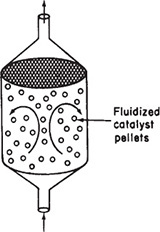
Fluidized CSTR
First write the rate law in terms of partial pressures and then express the rate law as a function of conversion.
P4-6A Orthonitroanaline (an important intermediate in dyes—called fast orange) is formed from the reaction of orthonitrochlorobenzene (ONCB) and aqueous ammonia (see explosion in Figure E13-2.1 in Example 13-2).

The liquid-phase reaction is first order in both ONCB and ammonia with k = 0.0017 m3/kmol · min at 188°C with E = 11,273 cal/mol. The initial entering concentrations of ONCB and ammonia are 1.8 kmol/m3 and 6.6 kmol/m3, respectively (more on this reaction in Chapter 13).
(a) Set up a stoichiometric table for this reaction for a flow system.
(b) Write the rate law for the rate of disappearance of ONCB in terms of concentration.
(c) Explain how parts (a) and (b) would be different for a batch system.

P4-7B Consider the following elementary gas-phase reversible reaction to be carried out isothermally with no pressure drop and for an equal molar feed of A and B with CA0 = 2.0 mol/dm3.
(a) What is the concentration of B initially? CB0 = _______ (mol/dm3)
(b) What is the limiting reactant? _______
(c) What is the exit concentration of B when the conversion of A is 25%? CB = ______ (mol/dm3)
(d) Write –rA solely as a function of conversion (i.e., evaluating all symbols) when the reaction is an elementary, reversible, gas-phase, isothermal reaction with no pressure drop with an equal molar feed and with CA0 = 2.0 mol/dm3, kA = 2dm6/mol2·s, and KC = 0.5 all in proper units –rA = _______.
(e) What is the equilibrium conversion?
(f) What is the rate when the conversion is
(1) 0%?
(2) 50%?
(3) 0.99 Xe?
is to be carried out isothermally first in a flow reactor. The molar feed is 50% H2 and 50% N2, at a pressure of 16.4 atm and at a temperature of 227°C.
(a) Construct a complete stoichiometric table.
(b) Express the concentrations in mol/dm3 of each for the reacting species as a function of conversion. Evaluate CA0, δ, and ε, and then calculate the concentrations of ammonia and hydrogen when the conversion of H2 is 60%. (Ans: CH2 = 0.1 mol/dm3)
(c) Suppose by chance the reaction is elementary with kN2 = 40dm3/mol/s. Write the rate of reaction solely as a function of conversion for (1) a flow reactor and for (2) a constant-volume batch reactor.
P4-9B Calculate the equilibrium conversion and concentrations for each of the following reactions:
(a) The reversible reaction
is carried out in a flow reactor where pure A is fed at a concentration of 4.0 mol/dm3. If the equilibrium conversion is found to be 60%.
(1) What is the equilibrium constant, KC, if the reaction is a gas phase reaction?
(2) What is the KC if the reaction is a liquid-phase reaction?
is carried out in a flow reactor with no pressure drop. Pure A enters at a temperature of 400 K and a pressure of 10 atm. At this temperature, KC = 0.25(mol/dm3)2.
(3) The gas-phase reaction is carried out in a constant-volume batch reactor.
(4) The gas-phase reaction is carried out in a constant-pressure batch reactor.
P4-10C Consider a cylindrical batch reactor that has one end fitted with a frictionless piston attached to a spring (Figure P4-10c). The reaction

with the rate law
is taking place in this type of reactor.
(a) Write the rate law solely as a function of conversion, numerically evaluating all possible symbols. (Ans.:–rA = 5.03×10–9[(1–X)3/(1 + 3X)3/2] lb mol/ft3·s.)
(b) What is the conversion and rate of reaction when V = 0.2 ft3? (Ans.: X = 0.259, –rA = 8.63× 10–10 lb mol/ft3·s.)
Additional information:
Equal moles of A and B are present at t = 0
Initial volume: 0.15 ft3
Value of k1: 1.0 (ft3/lb mol)2 · s–1
The spring constant is such that the relationship between the volume of the reactor and pressure within the reactor is
V = (0.1)(P) (V in ft3, P in atm)
Temperature of system (considered constant): 140°F
Gas constant: 0.73 ft3·atm/lb mol·°R
Supplementary Reading
Further elaboration of the development of the general balance equation may be found on the CRE Web site www.umich.edu/~elements/5e/index.html and also may or may not be found in
KEILLOR, GARRISON and TIM RUSSELL, Dusty and Lefty: The Lives of the Cowboys (Audio CD), St. Paul, MN: Highbridge Audio, 2006.
FELDER, R. M., and R. W. ROUSSEAU, Elementary Principles of Chemical Processes, 4th ed. New York: Wiley, 2015, Chapter 4.
HIMMELBLAU, D. M., and J. D. RIGGS, Basic Principles and Calculations in Chemical Engineering, 7th ed. Upper Saddle River, NJ: Prentice Hall, 2004, Chapters 2 and 6.
